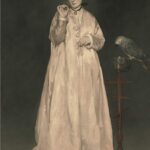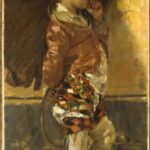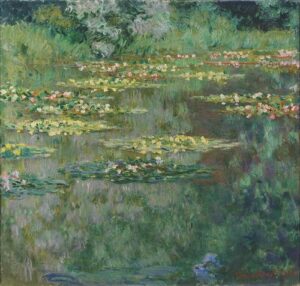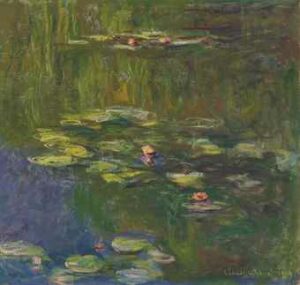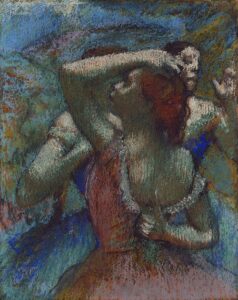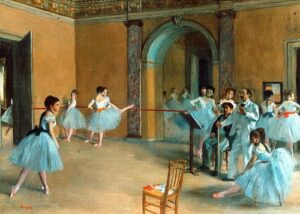
by James Francis Danby
(1816-1875)
When faced with a disaster, what would you save? Who hasn’t considered this classic rhetorical question? What would you rescue as you ran out the door in an emergency? Obviously the people and pets. But then it gets harder, and personal. The computer? Financial paperwork? Family heirlooms? Photo albums?
At the end of September, the question became real for me.
My husband Jack and I live on a boat about half the year. Having spent the summer aboard in Maine, we planned to take ‘Seadragon’ south for the fall and winter. Delayed by hurricanes Irma, Jose, and Maria, we were anxious to get underway and decided to do an overnight run from Portland to Provincetown. Fully fueled, we left about 5pm, a bit before sunset. As we approached the Cape Elizabeth lighthouse, I heard a soft ‘pop’ and a change in the engine sound. After checking with my husband at the helm, I headed for the engine room below deck. The porthole viewing window into the engine room was full of smoke and dripping from what I guessed was our fire suppressor. I didn’t open the door.
Running back up to the flybridge with the bad news, we began doing the things you hope you never have to. Jack shut down the engines and called a mayday to the Coast Guard, letting them know we might be abandoning ship. I got our life jackets and ‘ditch kit’, which holds some survival gear. We deployed the life raft. Then: are we ready? What else might we need? What was I not willing to lose? I grabbed our wallets – ID and a credit card would be nice if we were going to be ashore without a home, clothes or food. Still time? Glancing around I rejected clothes, medicine, and souvenirs. Those could all be replaced. Then I remembered – my Painting! The one I had ready to ship to OPA’s Eastern Exhibition in a couple of weeks! No question, that had to be the one thing I would grab. And there was time – barely.
As I stood on the deck, painting tucked under my arm, ready to jump, I was so sad to be leaving our boat, perhaps forever. Rescuing the painting eased that sense of loss and I knew I had made the right choice for me, on that day. Another time maybe it will be different. Of course, I’m actually hoping there won’t be a next time.
What happened next? Well, as I stood there, the Coast Guard arrived, my heroes! We had a scary transfer, jumping from our deck to theirs – but we all made it. Me, my husband, and the painting. The Coast Guard guys wondered what on earth they were protecting, ‘Must be really valuable’ they said. Yes. To me, it was.
And the rest of the story: The Portland fire boat arrived and our boat didn’t sink – it was towed back to the docks. We lost our life raft, had damages to repair, and weren’t real sure when we would get underway again. But we were fine, got to celebrate a warm welcome back to shore by wonderful people, and I still had a painting to show. It’s called “Potions” – but I’m thinking “Lucky Charm” might be its subtitle.

9×12, oil on panel
There were many lessons tucked into that day, from the Boy Scouts “Be Prepared”, to the philosophical “it could have been worse”. But the one I want to share is that while possessions have little value in a life-threatening situation, the work that we do as artists is more than an end product. It is a representation of how we spend our time, how we see the world, and what we want to share with the world. Our work is important, and worth saving.
We are so fortunate to have had only a close call. Our boat didn’t sink, and our situation pales in comparison to the stories of thousands of people who lost everything to the recent hurricanes and the west coast fires. For each of these families the question of what to save was real, and many didn’t even get the chance to answer the question. My heart goes out to all those who’ve lost their homes.
Oil Painting
Warm ups, a path to the “Zone”

Charcoal on paper
I loved watching the Golden State Warriors during the NBA basketball finals last June. Here we witnessed that exciting zone where players after hours upon hours of practice make a 3 point shot look effortless and even miraculous. The grace with which Stephen Curry releases a ball while blinded by his opponent and still makes the shot inspires me. Can I develop my visual memory to that same degree? Will my effortless brush stokes convey that subtle glance or capture that elusive gesture?
“Develop your visual memory. Draw everything you have drawn from the model from memory as well. Realize that a drawing is not a copy. It is a construction…A Drawing is an invention.”
~Robert Henri from The Art Spirit.
Through my work at the San Benito County Arts Council, I have had the opportunity to practice and teach a new technique in muscle memory. In one of the workshops we have two dancers from the San Benito Dance Academy model for us. I run through a series of quick one minute poses and build up to 20 minute poses over the course of 2 hours. All these small exercises are intended to build and develop visual memory.
The goal: Create muscle memory connecting eye, arm and brain to rapidly represent what is before the artist. Ultimately the goal is to be able to recreate the pose from memory when the model is not available. In my experience working from a live model that moves in a variety of poses throughout the workshop increases the number of poses recorded in muscle memory. The repeated one and two minute drawing exercises of head, shoulder, torso, hips, legs and arms applied in multiple gestures allows for a fluid library of poses to be committed to memory. This library of poses will be a tremendous resource to draw from in the future. As the artist commits to a disciplined schedule of quick gestural painted or charcoal studies, he or she will discover a rapid path to the artistic “zone,” where the memory will answer the aesthetic questions that cannot be answered by photo reference or the model who has been sitting for several hours.
Sketching With The Masters At The Met
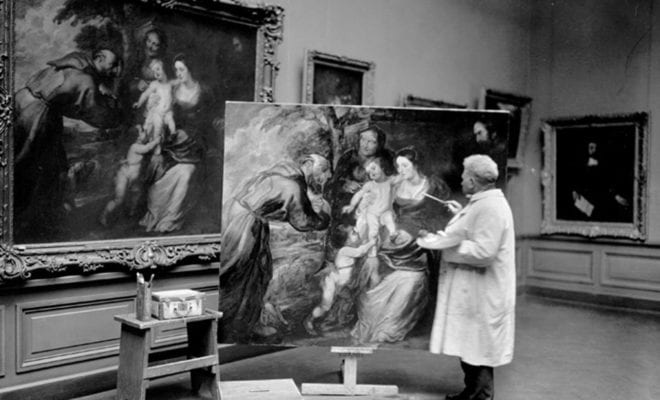
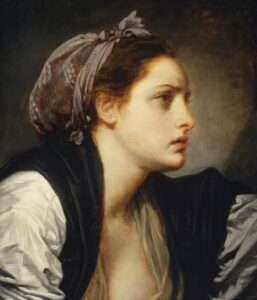
1870
“Study Head of a Woman”
I’m taking a class from the New York Academy of Art called Master Copying Class at the Metropolitan Museum of Art. Could anyone be a better teacher than a great master, despite, of course, being long dead? Fortunately, I also have a great living teacher, João Brandão, to help me interpret what I am looking at. Copying a painting at the Louvre or any great museum, a tradition going back many centuries, is how most of the great masters learned to paint. The Met’s Copyist program was founded in 1872, two years after the Met first opened, the program has provided countless artists the opportunity to copy the great works that fill the museum’s numerous galleries.
I’m so excited to take this class–in fact, so excited that I am 45 minutes early! Walking up the museum steps today (which I have done many times) felt strangely different. I really think this is going to be a great class. I loved copying the Romney painting at the Philadelphia Museum of Art, which I did without the benefit of a class. My friend Dr. Hal Shanis and I just decided we wanted to do it. We really didn’t know the ins and outs of what we were supposed to do, but had a terrific time doing the paintings and figuring everything out. This is much more formal and feels more like it might be like the high bureaucracy of the Louvre though I don’t think there are any interviews or other hurdles. In fact, the painting schedule is already set.
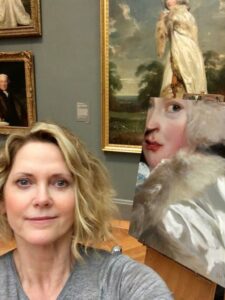
The first day the class met with NYAA teacher João Brandão in the Uris Center for Education in a conference room near the copier office at the Met. We talked about the rules of the Met and the schedule. (The Met has strict guidelines for copying not only out of fear of forgeries, which would exclude large and popular paintings, but also for such practical reasons as the traffic in the gallery where the painting is located. For all the guidelines see www.metmuseum.org.) We then took a guided tour of the Thomas J. Watson Research Library, which has one of the most comprehensive collection of books and periodicals on the history of art in the world. The rest of the day was spent combing through paintings that were on the approved list from the curators from the different galleries of the Met. Below are some of the paintings I was hoping to paint but, unfortunately, were either not on the approved gallery list or were not approved by the curator. Sooo frustrating!
“Young Lady in 1866”
“Mathew B. Brady”
“A Maid Asleep”
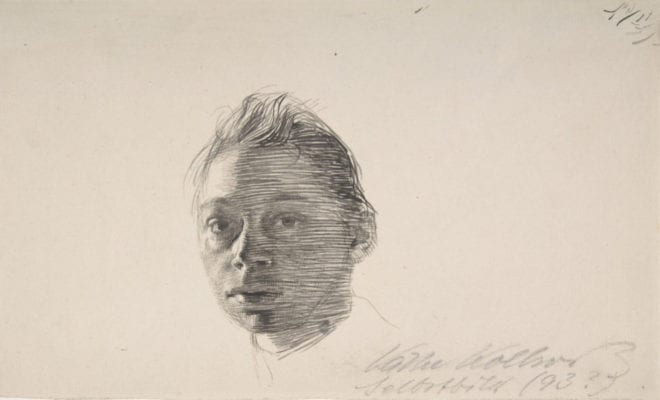

1504
Albrecht Dürer
German, Nuremberg 1471–1528 Nuremberg
I forgot to mention the best day of our non-painting days. It was to visit the Met’s Drawing and Prints Department. This is where we met brilliant Laurie Murphey, the Met’s education person in charge of the copyists. (Copyists are the students, like us, who copy a master painting.) Our class, of only 4, was shown 4 or 5 drawings at a time, from Leonardo da Vinci to Rembrandt. These original master sketches were pulled out of boxes and put on desk easels in front of us. We each picked one and started sketching. What an off-the-charts fabulous exercise, which the other schools also had an opportunity to do on different days!
To find out more about my experience at the Met, follow me on my blog!
What DO YOUR Eyes See?
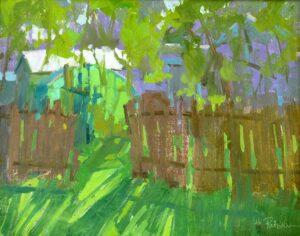
8″ x 10″
I see the world as big, abstract pieces. This painting and the colors in it are exactly how this backyard scene with a greenhouse looked to me. (Here is a photograph of the same scene).
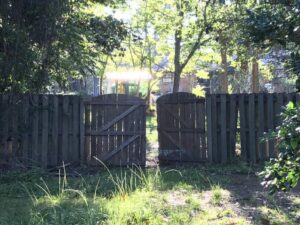
A little over a week ago I had cataracts removed from my right eye and a lens implant. (I know what you’re thinking… “But you’re so young!” Why yes I am, thank you very much for noticing.) My doctor has known me for over 30 years and has been very curious about my artist’s sight and sense of color. In fact, Dr. Gary Jerkins and I have discussed theories on Monet’s and Degas’ cataracts, something HE had studied and wanted to know my thoughts. When my cataracts very first began developing, I noticed. Seems I’m something of a little Princess actually because I had two different types. My surgeon, Dr. Rebecca Taylor, couldn’t believe I could even tell yet, as the cataracts were hardly developed at all. Most non-artists likely wouldn’t have thought anything was going on for 10 or 15 years more.
Flash forward to my post-op appointment. As soon as my doctor removed the eye patch, I could immediately tell that the left eye needs surgery too. It hadn’t been noticeable before because the right was a bit worse. The second thing I could really measure was the difference in color I could see with my new right eye. Unbelievable. I mean, these were beginning stages cataracts and I could sincerely notice the difference.
It is not uncommon for students in my workshops to challenge me on the colors I use. Oftentimes someone will say something like, “Well that’s a pretty color you used, but it sure isn’t what’s there.” I have even had students actually argue with me that I am just making up colors completely, even though I am not.
The truth, and what I try to teach them, is that we all perceive color differently. I’m not even talking about people with color blindness. I’m talking about people who see color as distinctly as you or I think that we do. What may appear as blue to you could appear green to someone else. It makes sense that this certainly happens easily between colors that are very near one another. Think of it as measuring blue-green and green-blue on the color wheel. Some people will find it difficult to tell which is which. However, many other factors can also play a role in perceived color difference.

Credit: American Academy of Ophthalmology
It’s nothing new to imagine how many famous artists through time have developed cataracts. Claude Monet, for example, reportedly developed cataracts around 1912. He had been painting his waterlily works since before the turn of that century. As the cataracts progresses, so too did the colors of his paintings. His works between 1918-1922 show muddier and darker tones, larger brush strokes, and indistinct coloration, particularly the absence of light blues. According to the National Gallery, London, it is widely accepted that he also had a form of cataract removal at age 82. Some researchers believe that Monet simply decided on a stylistic change, but in his own words, he penned, “To think I was getting on so well, more absorbed than I’ve ever been and expecting to achieve something, but I was forced to change my tune and give up a lot of promising beginnings and abandon the rest; and on top of that, my poor eyesight makes me see everything in a complete fog. It’s very beautiful all the same and it’s this which I’d love to have been able to convey. All in all, I am very unhappy.” – August 11, 1922, Giverny. He wrote that “colors no longer had the same intensity for me . . . reds had begun to look muddy . . . my painting was getting more and more darkened.” He felt that he could no longer distinguish or choose colors well and was “on the one hand trusting solely to the labels on the tubes of paint and, on the other, to force of habit.”
Degas, who also developed what is believed to have been macular degeneration. According to the Vision and Aging Lab, by his forties, Degas developed a loss of central vision. Painting became even more difficult, as he was forced to paint around this scotoma. Later on, Degas had problems identifying colors and asked his models to identify the colors of his media. His vision became progressively worse, and by 1891, at age 57, he could no longer read. “I see even worse this winter, I do not even read the newspapers a little; it is Zoé, my maid, who reads to me during lunch. Whereas you, in your rue Sadolet in your solitude, have the joy of having your eyes… Ah! Sight! Sight! Sight!… the difficulty of seeing makes me feel numb.” – Degas in a letter to friend, Evariste de Valernes, Paris, 6 July, 1891.
Dancers, 1900
Rehearsal of the Scene, 1872
From 1870 until his death in 1917, Degas sought the advice of a number of different ophthalmologists. Many theories have been put forward regarding the nature of his problem, including retinal disease, hereditary degeneration, corneal scarring and age-related macular degeneration (ARM). He was diagnosed with “chorioretinitis”, a term then used commonly to describe a variety of eye conditions. Degas’ difficulty in distinguishing colours, sensitivity to light, and scotoma all point to some sort of retinal disease. It is not clear whether his retinopathy was acquired or inherited.
Just a tidbit of interesting info regarding how we see color: Cones are one of three types of photoreceptor cells in the human eye. They are responsible for color vision. It is a huge simplification for this particular post, but basically red, green, and blue. Sea creatures can see thousands or millions more colors with many more cones. Roughly 2% of females have an extra color cone. More on that in a later post.
“Confidence” Should be a Tube of Paint
Real confidence only comes from study and practice.—Harley Brown
As I’ve been preparing to paint lately, I’ve been thinking about how great it would be if “Confidence” were just a color I could squeeze out onto my palette. It would mix smoothly with all the other colors, and give each brushstroke the snap and spring that would bring those flat shapes to life, to imbue those colored spots and masses with the energy and authenticity that would ultimately make my painting sing in a frame on the gallery wall.
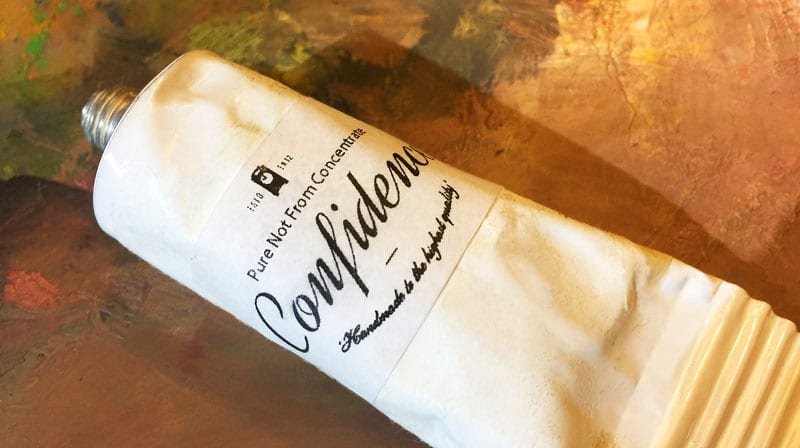
Alas, I can’t find it on the aisles of the art store. It’s not bottled, boxed, compressed, or container-ed. I have been able to read about it: how it changes lives, impels men and women to the top of Mount Everest and to the bottom of the South Pole. It was inside Amelia Earhart’s leather pilot’s helmet when she flew across the Atlantic in one go, for the first time, and on the shoulders of General George Patton’s short jacket as he out-thought and out-fought German commanders across Europe and Africa. You can see it in Monet’s impressionist markings in the “Water Lilies” series in the Musée De L’Orangerie, and in the economic charcoal drawings of Picasso and Georgia O’Keeffe. Sometimes it seems like it’s everywhere I’m not.
Robert Genn was a prolific writer and artist, a Canadian with a can-do sense of life, and while he was here he wrote about things in life that way. He wrote, “To float like a cloud, you have to go to the trouble of becoming one.” Wow. That’s my goal, to paint like I breathe: easily, effortlessly, and economically. I’ve heard workshop instructors tell their students, “Use the Big Brush! Paint with Confidence, and Boldly! Go Big or Go Home!”

16×20 oil
currently showing at Western Regional OPA 2017
Bottom line, Rick, sorry, guy, you’re only going to paint with confidence after you paint miles of canvas. There is no other way. I guess I should say, “Go Hard or Go Home.”
That’s why artists, or anyone who wants to do their work confidently, has got to love what they are doing, and possess a driving passion to do it. That way, mistakes and failures won’t sink the ship: they’ll just be more coal that you can feed the boilers to keep going full speed ahead.
Okay, then, back to work so-I can Paint with Confidence!
To see more of my work, go to delantyfineart.com
